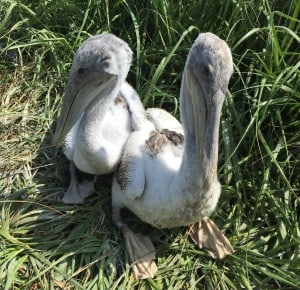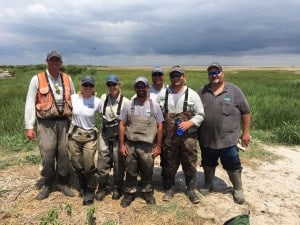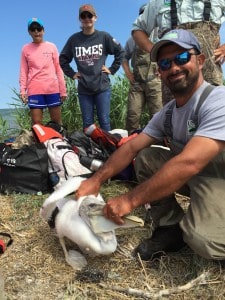Share this article
Banding the Bay’s Pelicans
Early on a beautiful July morning professionals from local wildlife agencies and volunteers met at a Crisfield, Maryland boat ramp. Our destination? Smith Island, a small series of islands on the Maryland-Virginia border, home to a unique community and Maryland’s official state dessert, the Smith Island cake. Although cake is a worthy reason for a visit (so are the crab cakes), our focus would be the island’s southwest end where a large colony of brown pelicans was nesting.
Given today’s numbers, it’s hard to believe brown pelicans weren’t documented breeding in the Chesapeake Bay until 1987. Dave Brinker, Biologist with Maryland’s Department of Natural Resources, saw these early breeders as an opportunity to learn about the pelican’s breeding range expansion and thus banded all chicks from the original five pairs established along coastal Worchester County, Maryland.
And expand they did. Pelicans began breeding throughout the Chesapeake Bay islands. The number increased to 114 pairs in 1997 and then exploded in 1999 with an estimated 1,000 breeding pairs!
Since the Chesapeake Bay includes Maryland and Virginia, inter-state communication was critical to understand the behavior and biology of the Bay pelican population. Dave coordinated closely with John Weske, a master bander in Virginia, to monitor and band the pelicans, ensuring a complete data set for both states.
USDA’s Wildlife Services in Maryland has been helping with the annual pelican banding project since 2008, providing needed boats and skilled staff. Pelicans nest in large colonies, often with several hundreds of young. Having lots of volunteers is essential to help corral, sort, and band the juveniles. Young pelicans can be quite intimidating with their over-sized snapping bills and nasty habit of throwing up their last meal when they feel threatened. This July afternoon USDA employees joined interns from the U.S. Fish and Wildlife Service, U.S. Geological Survey and other volunteers. Crews began at one end of the island, working in concert to corral small groups of birds to be banded. When the decision was made to head home, the teams had banded 1,000 juvenile pelicans in just a few short hours.
These banded birds provide invaluable data, helping Dave and John understand the migration and biology of these magnificent birds. The Chesapeake population is the northernmost breeding population. Also the most migratory, the birds generally spend their winters on Florida’s east coast. A smaller proportion may winter in Cuba, but birds have been reported as far away as Bermuda, Jamaica, and the Dominican Republic. Where will this July’s banded birds go? Some won’t make it out of the Chesapeake – the first year is always the hardest. Some will survive and, hopefully, return next year to start the whole process over again.
Wildlife Services is a Strategic Partner of TWS.
Header Image: Image Credit: USDA Wildlife Services











